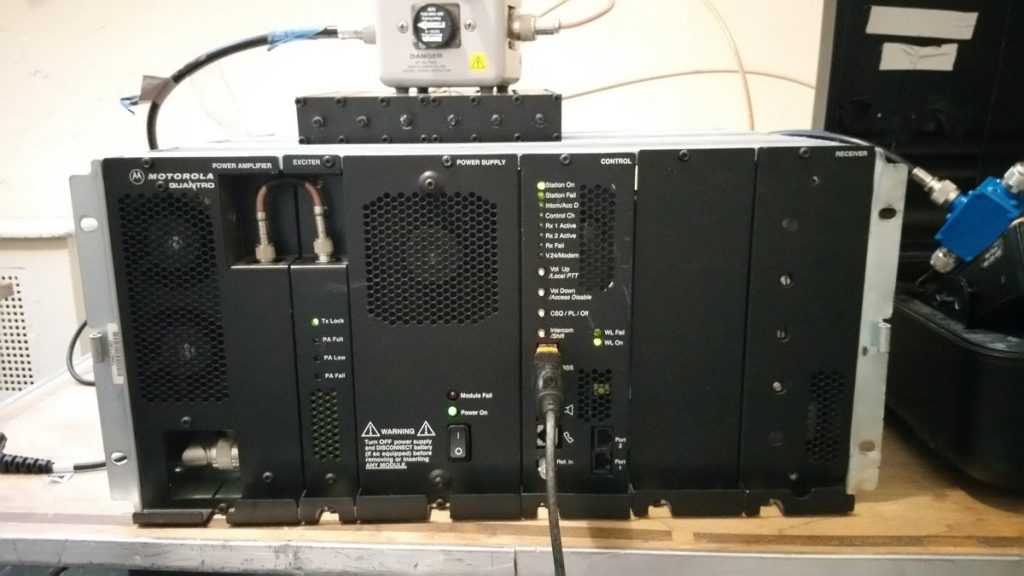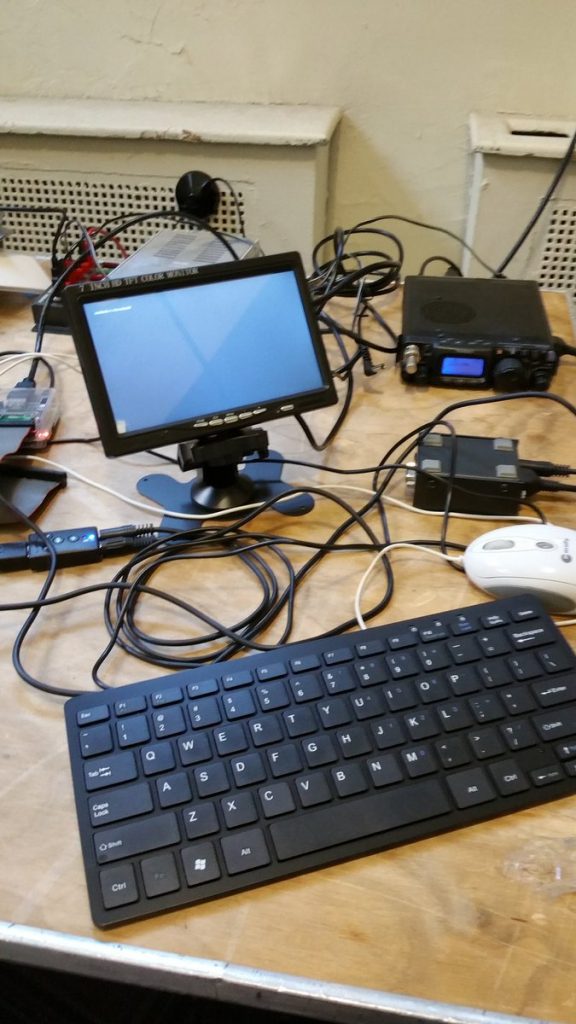The Hackers on Planet Earth (HOPE) Conference is a biennial event held at the Hotel Pennsylvania in New York City that I’ve been attending for the past ten years. Each conference I join a small group of volunteers in setting up and operating a special event Amateur Radio station with HF and VHF capability.

In the past, HF activity has mostly been digital modes using PSK31 on 40 and 20 meters. VHF activity mostly simplex FM contacts with fellow attendees who are licensed Hams using their handhelds at the conference. All contacts would be acknowledged with a special event QSL card.
But making VHF contact with the Special Event station was the only usage we saw many of the Hams make of their handhelds. I thought it rather interesting the first social tool available to hackers that was not designed to track you was not being used at all. What would it take to get them to use it rather than worn as an adornment.
How about a repeater for HOPE ?
While I was spending Winter 2016 on some Amateur Radio projects I began thinking about the upcoming HOPE XI conference in the summer. One of the projects I was working on was building a low cost UHF Amateur Radio repeater station using cheap mobile radios and a Raspberry Pi serving as the repeater controller. I contacted “Bernie”, a well-known HOPE organizer who among his many responsibilities organizes the Amateur Radio volunteers, to see if the organizers had interest in having a repeater setup for HOPE XI. The response was an immediate “YES !”
But like needing land first before you can put a building on it, we need to find if there was available spectrum in Manhattan that we could host a repeater on temporarily. There are repeater coordination councils across the United States that help the amateur radio community make efficient use of the available VHF/UHF spectrum. Metropolitan Coordination Association, Inc. (MetroCor) is one of those councils and is a volunteer group of concerned Amateurs that address spectrum usage issues in one of the most densely populated areas of the country, the New York Metropolitan area. Before work could begin on a repeater for the conference, I needed to contact MetroCor for available spectrum informing them it would be for a temporary repeater setup only for the duration of the HOPE conference.
Within 24 hours of contacting MetroCor with the requested details of the planned installation, they approved the request and provided a temporary frequency pair and PL/CTCSS tone to be used for both transmit and receive. MetroCor is one of the few coordinating councils that reserves a frequency pair for emergency situations and special requests. With the special event call W2H reserved, we just needed to make sure we had a working repeater.
Building a Repeater
I had a working repeater prototype on my bench that consisted of two QYT-KT8900R radios connected to a UHF duplexer and a VHF/UHF base antenna. The two radios were new brands out of China that I bought as a pair for around $160 USD.

I also ordered a UHF duplexer out of China pre-tuned to the repeater frequency pair that MetroCor issued for a cost of under $90 USD. For the controller, I was running SVXlink on a Raspberry Pi using a USB sound dongle and Easy DIGI for the audio interface. SVXlink was configured for VOX on receive and USB-to-Serial for PTT for transmit. The working prototype also included EchoLink connectivity and a voting receiver system that used an RTL-SDR as the second receiver.
While the prototype functioned well, work remained on removing the use of VOX on receive since it had impact on maximizing controller functionality that depended on DTMF detection. So when Bernie contacted me saying another well-known HOPE organizer and well-known security researcher, Matt, had a Motorola Quantar repeater plus commercial grade antennas we could use, we opted to go that route instead of investing further on the prototype.

Afterall, the goal here was to get Hams at HOPE to use that social tool strapped to their belts, handhelds, and that required a repeater Hams would have confidence in that it was up and running at all times during the conference.
Setting up Special Event Station W2H
It was the Thursday afternoon before the start of HOPE and the small group of volunteers (old faces and some new) gathered to help setup the special event station. As with past HOPES, this starts with installing the antennas on the roof and running feedline down to the operating position on the 18th floor. Access to the roof is restricted and is always coordinated with Hotel management.
At minimum we run with two antennas, a dipole for HF, and a vertical for VHF/UHF. Since the best height and length for a HF wire antenna on the roof can accommodate 40 meters, our contacts with an antenna tuner have been on 40, 20, 15, and Meters. This year we ran a G5RV Jr for HF, a commercial UHF antenna for the repeater, and another VHF/UHF antenna for FM simplex or as a second antenna for the repeater should we have duplexer issues. We also ran a fourth feedline should we decide to setup another antenna for some other purpose.

Once the antenna and feedline work was complete, feedline was connected to the duplexer I ordered out of China that was already pre-tuned to the repeater frequency pair we were going to use. The duplexer in turn was connected to the Quantar.

The Motorola Quantar then needed to be programmed via PC as a repeater inclusive of ID, timeouts, etc. The licensed commercial software required to program the repeater is as vintage as the repeater itself. Once Matt programmed the repeater we fired it up. Other than some tweaking, the repeater remained up throughout the conference with no outages or desensing issues.
W2H/R is on the air!
I think “gobsmacked” best described the look Matt and I sported throughout the weekend when it came to the repeater’s performance.
What’s the coverage area ?
When it came to repeater coverage, we were just focused on usability by attendees in the Hotel and around midtown. With 20 Watts out on the Quantar, and gains/losses from the antenna system (duplexer inclusive) we figured our target coverage would be accomplished and then some. “Then some” ended up including contacts in Yonkers, Queens, Jersey City, Hoboken, and Paramus. The other day I was able to compare our contacts to a coverage plot generated by the Radio Mobile site by VE2DBE .

Coordinating repeaters for densely populated is difficult given the limited spectrum available. For the Northeast corridor it is not uncommon for repeaters 75 miles apart to have overlapping coverage especially during fall and winter when there is no foliage on the trees. The use of differing PL/CTCSS tones by repeaters sharing the frequency and Hams configuring their radios in kind with PL/CTCSS on transmit and tone squelch on receive helps make good fences for good neighbors.
Such was the case with our repeater. The frequency pair provided by MetroCor had us sharing a frequency pair with a repeater 20 miles west, W2QR, run by the West Orange Repeater System. We did not realize this until we were on the air and started hearing the other repeater. Given the coordination through MetroCor with each repeater systems and its users using the PL/CTCSS tone assigned, there were no known complaints. “Many Thanks” to our neighbors in the West Orange Repeater System.
EchoLink . . . please
But with all the success there was one frustration – I wanted to provide EchoLink access to Hams who could not make it to HOPE and especially for those Technician class Hams since they had no HF privileges to contact us. With the view of “if it ain’t broke, don’t fix it” rather than mess with the repeater itself I looked into setting up a standalone station with EchoLink connectivity and have it connect to the repeater like any other user.
I took the portable digital station I brought with me and reconfigured it as a standalone UHF station with EchoLink connectivity via the “SVXlink-on-Pi controller” I had with me and reconfiguring it from repeater to simplex. Within minutes of asking, the HOPE XI NOC provided us a wired connection to use for Internet access by the SVXlink controller. Many Thanks to the HOPE XI NOC.

Long story short I had no problems bringing the EchoLink up through the repeater but there were too many issues with the audio and RF getting back into the audio wrecking havoc with the VOX configuration constantly “kerchunking” the repeater. Contributing to this was working in a very hot room to get it all going. I eventually gave up and resolved myself to insuring we have EchoLink functionality at a future HOPE.
What else ?
While this post focused just on the repeater activity, know that there was plenty of HF digital mode activity mostly with JT65 on 20 meters. Since this was the first HOPE I didn’t work on the HF setup, I will chat with those involved and see about it getting discussed on their blogs or this one.
If you were at HOPE XI and used the repeater, I would love to hear your experience with it and what features you would like to see in a future HOPE repeater.
If you were part of the group of volunteers that made the special even station possible, let me know of anything I missed or misrepresented and will update. Always great catching up, meeting new people and working with each of you.
As for the repeater prototype I built, work continues on the “SVXlink-on-Pi controller” and I will be blogging about it shortly.
For what it’s worth,
- Joe, NE2Z
